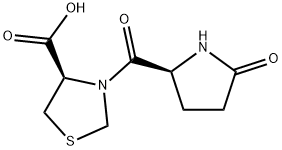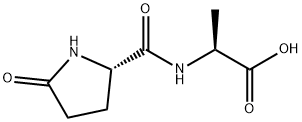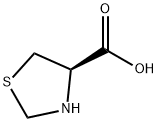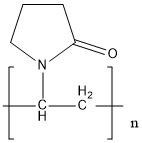Pidotimod , ≥98% , 121808-62-6
Synonym(s):
(4R)-3-(5-Oxo-L-prolyl)-1,3-thiazolidine-4-carboxylic acid;(R)-3-((S)-5-Oxopyrrolidine-2-carbonyl)thiazolidine-4-carboxylic acid;(R)-3-[(S)-(5-Oxo-2-pyrrolidinyl) carbonyl]-thiazolidine-4-carboxylic acid;3-L-Pyroglutamyl-L-thiaziolidine-4carboxylic acid;PGT/1A
CAS NO.:121808-62-6
Empirical Formula: C9H12N2O4S
Molecular Weight: 244.27
MDL number: MFCD00867583
EINECS: 2017-001-1
| Pack Size | Price | Stock | Quantity |
| 5G | RMB312.80 | In Stock |
|
| 25G | RMB930.40 | In Stock |
|
| 100G | RMB2076.80 | In Stock |
|
| others | Enquire |
PRODUCT Properties
| Melting point: | 194-198°C (dec.) |
| alpha | D25 -150° (c = 2 in 5N HCl) |
| Boiling point: | 663.0±55.0 °C(Predicted) |
| Density | 1.53 |
| storage temp. | Keep in dark place,Sealed in dry,2-8°C |
| solubility | DMSO (Slightly, Heated), Methanol (Slightly, Heated), 5N HCl (Slightly) |
| form | powder |
| pka | 3.03(at 25℃) |
| color | white to beige |
| optical activity | [α]/D -135 to -155°, c = 1 in 6 M HCl |
| Water Solubility | H2O: 2mg/mL, clear (warmed) |
| Merck | 14,7419 |
| InChI | InChI=1S/C9H12N2O4S/c12-7-2-1-5(10-7)8(13)11-4-16-3-6(11)9(14)15/h5-6H,1-4H2,(H,10,12)(H,14,15)/t5-,6-/m0/s1 |
| InChIKey | UUTKICFRNVKFRG-WDSKDSINSA-N |
| SMILES | S1C[C@@H](C(O)=O)N(C([C@@H]2CCC(=O)N2)=O)C1 |
| CAS DataBase Reference | 121808-62-6(CAS DataBase Reference) |
Description and Uses
Pidotimod, a dipeptide immunomodulating agent, has been introduced as immunostimulant therapy in patients with cell-mediated immunosuppression during respiratory or urinary tract infections. Its mode of action on the immune system is by activation of T-lymphocytes via interleukin (IL)-2 stimulation and macrophages via activation of superoxide dismutase and chemotaxis. In mice, treatment with pidotimod causes significant increase in the natural killer cell activity that may play an important role in immunosurveillance against tumors and in physiological homeostasis. Pidotimod can reverse the immunosuppression caused by surgical stress and has antiinflammatory, antioxidant, and antiaging properties. It has also been reported to provide protection from bacterial infections in mice.
immune stimulant
Safety
| Symbol(GHS) |  GHS07 |
| Signal word | Warning |
| Hazard statements | H302-H315-H319-H335 |
| Precautionary statements | P261-P305+P351+P338 |
| RTECS | XJ5426675 |
| HS Code | 2934.10.9000 |
| Toxicity | LD50 in mice and rats (mg/kg): >4000 i.v.; >4000 i.m.; >8000 i.p.; >8000 orally (Coppi) |





